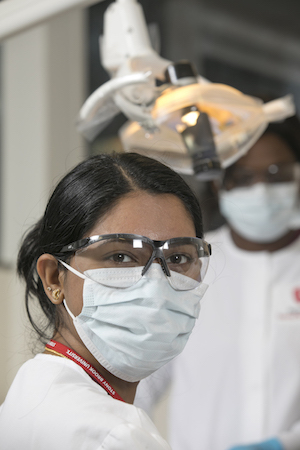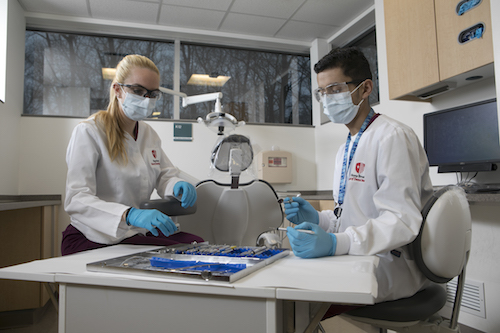 Dental Assisting Chairside I is a lecture and laboratory course designed to introduce the students to the profession of dentistry, the dental health team, and to acquaint the student in the procedures and instrument armamentarium of four-handed dentistry. The student is required to know and show competency in equipment preparation and maintenance, patient control, instrument identification and usage, tray set-ups for general dentistry, and sterilization. Dental Assisting Chairside I provides the major instruction in assessment, which includes, taking and recording medical histories and vital signs, assisting with and performing extra and intraoral exams, and dental charting. Dental Assisting Chairside I provides knowledge and skill in preparing tray set-ups, seating and dismissing patients, applying current concepts of four-handed chairside assisting and assisting and applying topical anesthetic and fluoride agents. Dental Assisting Chairside I also provides knowledge and skill in providing patient education and oral hygiene instruction, providing pre- and post-operative instructions provided by the dentist, maintaining accurate treatment records, and maintaining treatment areas.
Dental Assisting Chairside I is a lecture and laboratory course designed to introduce the students to the profession of dentistry, the dental health team, and to acquaint the student in the procedures and instrument armamentarium of four-handed dentistry. The student is required to know and show competency in equipment preparation and maintenance, patient control, instrument identification and usage, tray set-ups for general dentistry, and sterilization. Dental Assisting Chairside I provides the major instruction in assessment, which includes, taking and recording medical histories and vital signs, assisting with and performing extra and intraoral exams, and dental charting. Dental Assisting Chairside I provides knowledge and skill in preparing tray set-ups, seating and dismissing patients, applying current concepts of four-handed chairside assisting and assisting and applying topical anesthetic and fluoride agents. Dental Assisting Chairside I also provides knowledge and skill in providing patient education and oral hygiene instruction, providing pre- and post-operative instructions provided by the dentist, maintaining accurate treatment records, and maintaining treatment areas.
Dental Assisting Chairside II is a lecture and laboratory course specific to dental specialties including pediatrics, endodontics, oral surgery, prosthodontics, periodontics, and orthodontics. In addition, special lectures are presented by dental faculty for each of the specialties. Special management concerns of medically and developmentally compromised patients are correlated within the course.
Dental Materials I is a lecture and laboratory course designed to introduce students to the basic principles of dental restorative materials and techniques and to introduce the structure and matter and the physical and mechanical properties of selected dental materials fundamental to restorative dentistry. Dental Materials I provides knowledge and skill required to take preliminary impressions, study casts, and occlusal registrations. Dental Materials I provides knowledge and skill in assisting and placing and removing a rubber dam, assisting placing base, liners, and bonding agents, assisting and placing matrix retainers, bands and wedges, fabricating whitening trays, and manipulating dental materials.
Dental Materials II builds on Dental Material I with additional clinical and laboratory experience. Dental Materials II provides knowledge and skills in fabricating custom trays, manipulating permanent cements. The student will become proficient in the recognition, manipulation, and management of dental materials utilized in all aspects of the practice of dentistry.
Operative Technique is course where students receive lecture and laboratory training to laboratory competence, in the placement and carving of intra-coronal Class I, Class II, and Class V amalgam restorations to the accepted standards of occlusal and physiologic contours, the placement, curing and finishing of intra-coronal tooth-colored restorations to accepted physiologic, occlusal and esthetic standards, and the placement, contouring and removal of temporary restorations, cleaning and polishing removable appliances and prostheses, fabricating provisional restorations.
Bio-Medical Science I is an integrated lecture and laboratory course of human anatomy and physiology, with an overview of the human body. The course includes a basic introduction to the body structure, systems, and function, basic concepts in microbiology, oral histology and embryology, oral pathology, micro-organisms, immunology, cells and tissues and infection control. The biomedical science course offers in-depth course content in the areas of bloodborne pathogens and hazard communications standards. “Right to Know,” an infection and hazard control course offered by the School of Dental Medicine is mandatory for every student prior to entering the clinic.
Bio-Medical Science II is a continuation of Bio-Medical Science I with emphasis on oral histology and embryology, oral pathology, human immunology, cardiovascular and nervous systems, and the correlation of all human systems, body functions, and structures.

Oral Anatomy is a lecture and laboratory course designed to introduce the students to the structural and functional interrelationship of the hard and soft tissues of the oral cavity and neck, and the supportive structures of the human dentition. Students are introduced to the morphology of the primary and permanent dentitions, eruption sequence of the human dentition, and the basic concepts of occlusion and mastication.
Dental Radiology I is a lecture, laboratory, and clinical course providing the student with the basic principles of radiation physics and concepts of radiation safety in the dental office. Through specific assignments and practice in direct application, the student will learn the types of radiographs, exposure, and processing techniques of diagnostic dental radiographs. The student will be introduced to the principles and methods utilized in the paralleling and bisecting angle techniques, intra and extraoral radiographic surveys used in dentistry, and principles of radiographic interpretation. The student will successfully pass competency on placing and exposing radiographs on a manikin prior to a patient experience. The student will become familiar with the types and maintenance of dental radiograph processors.
Dental Radiology II is a continuation of Radiology I with emphasis on the clinical application of previous information and skills obtained. The emphasis is on the quality control of radiographs, selection of appropriate radiographic procedures, recognition of anatomic landmarks and the skill to differentiate between normal and abnormal dental conditions. Experience is obtained through continued classroom evaluations and clinical practice within the radiology suite. Panoramic surveys are included in the intra-oral radiographic experience.
Dental Office Management, Communication, and Basic Behavioral Concepts provide a lecture series with practical experiences designed to prepare the student in dental office management and oral communication within the dental setting with emphasis on proper communication skills for telephone conversation, and basic skills of daily communication use. The student also receives mentoring in written communications. Emphasis will be placed upon behavioral concepts of patient psychology and personal issues. The course provides the student with an overview of business ethics and jurisprudence, office management and business skills. Students are acquainted with appointment book control and insurance forms. The course provides knowledge and skill required for business office procedures including, managing telephones, controlling appointments, performing financial transactions, completing insurance reimbursement forms, maintaining supply inventory, managing recall systems, and operating business equipment.


